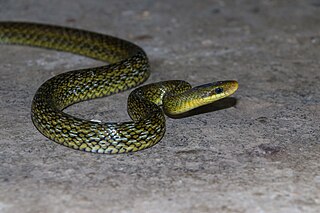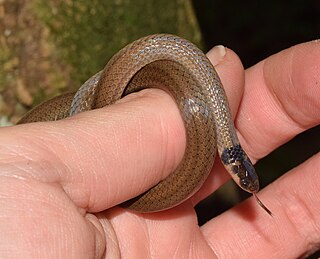
The Himalayan keelback is a species of grass snake in the family Colubridae. The species is endemic to South Asia.

Platyceps gracilis, commonly known as the graceful racer or slender racer, is a species of snake endemic to India.

Elaphe hodgsoni, the Hodgson's rat snake, is a species of snake in the family Colubridae. The species is found in parts of Asia around the Himalayas.

Sibynophis collaris, commonly known as the common many-toothed snake,Betty's many toothed snake or the collared black-headed snake, is a species of colubrid snake endemic to South and East Asia.

Hydrophis melanocephalus, commonly known as the slender-necked sea snake, is a species of venomous sea snake in the family Elapidae.

Günther's black snake is a species of poorly known lamprophiid snake endemic to central Africa. It is the only member of the genus, Bothrolycus. This snake is notable as one of the few snakes with notable sexual dimorphism, as well as possessing a small pit anterior to the eye. While superficially similar to the thermal pits of vipers, its function remains unknown.
Hypoptophis is a monotypic genus created for the rear-fanged (opisthoglyphous) mildly venomous snake species, Hypoptophis wilsonii. The species, which is endemic to Africa, is in the subfamily Aparallactinae of the family Atractaspididae. There are no subspecies that are recognized as being valid.
Aparallactus lineatus, or the lined centipede-eater, is a species of mildly venomous rear-fanged snake in the family Atractaspididae.
Aparallactus niger is a species of mildly venomous rear-fanged snake in the family Atractaspididae. It is endemic to Western Africa.
Micrelaps vaillanti, also known commonly as the black-headed micrelaps or the Somali two-headed snake, is a species of venomous rear-fanged snake in the family Lamprophiidae. The species is endemic to Africa.
Polemon barthii, or the Guinea snake-eater, is a species of rear-fanged mildly venomous snake in the family Atractaspididae. The species is endemic to Africa.
Polemon christyi, also known commonly as Christy's snake-eater and the eastern snake-eater, is a species of venomous rear-fanged snake in the subfamily Aparallactinae of the family Atractaspididae. The species is native to Central Africa and East Africa.

Polemon collaris, or the collared snake-eater, is a species of mildly venomous rear-fanged snake in the family Atractaspididae. It is endemic to Africa.
Polemon gabonensis, or the Gaboon snake-eater, is a species of mildly venomous rear-fanged snake in the family Atractaspididae. It is endemic to Africa.

Aparallactus capensis, or the Cape centipede-eater, is a species of mildly venomous rear-fanged snake in the Atractaspididae family.

Aparallactus guentheri, or the black centipede-eater, is a species of mildly venomous rear-fanged snake in the family Atractaspididae. The species is endemic to Africa.
Aparallactus jacksonii, or Jackson's centipede-eater, is a species of mildly venomous rear-fanged snake in the family Atractaspididae.

Aparallactus lunulatus, or the reticulated centipede-eater, is a species of mildly venomous rear-fanged snake in the family Atractaspididae, which is endemic to Africa.

Aparallactus modestus, or the western forest centipede-eater, is a species of mildly venomous rear-fanged snake in the Atractaspididae family.
Aparallactus nigriceps, or the Mozambique centipede-eater, is a species of mildly venomous rear-fanged snake in the family Atractaspididae.










